Planning your own trip? Prepare for your trip
Use Rough Guides' trusted partners for great rates
- Portugal
- Algarve
Plan and book your private, tailor-made tour with vetted local experts
Sagres is the southwesternmost harbour in Europe. Set on a flat, scrubby headland above a working fishing port, it’s not the prettiest town, but its raw setting draws surfers, divers, backpackers, and families. Warm waters, steady waves, and a string of wild beaches keep people coming back.
Modern Sagres is built along Rua Comandante Matoso, which runs from the harbour and Praia da Baleeira to the main square. Behind it, white villas and apartments make up the bulk of the town. Praça da República, the central square, is a cobbled space with squat palms and a few relaxed cafés. Things liven up on August 15 when fireworks and parties mark the local saint’s day.

Tips from Joel
Portugal Travel Expert

Hey, I’m Joel, your Portugal travel expert. I’ve spent years exploring the Algarve, but Sagres always hits different. Tucked into the windswept tip of the southwest coast, this is a place where cliffs fall into the Atlantic, surfers chase the next break, and everything moves at its own pace. This Sagres travel guide covers the essentials: how to get there, what not to miss, and where to crash after a day in the sun.
Sagres is all about the elements. Expect wind in your hair, salt on your skin, and sunsets that make you stop mid-sentence. Hit the surf at Tonel or Beliche, grab a plate of grilled octopus in the harbor, or walk the cliff path to Cabo de São Vicente, once thought to be the end of the known world. Big sights include the 16th-century Fortaleza, the lighthouse, and dramatic beaches, but the real charm is in the mood of the place. Slow, raw, and quietly wild.
Joel’s tip
Head to Cabo de São Vicente just before sunset with a jacket and a cold beer. The wind howls like it’s trying to blow you off the continent, gulls dive straight into the sea, and the sun drops off the edge of the world. It’s not peaceful. It’s epic.
Best time to visit
Late spring (May to June) and early autumn (September to October) hit the sweet spot, with warm weather, fewer crowds, and decent surf. July and August bring heat, wind, and bigger crowds. Winter is quieter, still sunny, but breezy enough to keep your hoodie on.
How to get to Sagres
Sagres isn’t on a train line, so driving is the best option. It’s about 3.5 hours from Lisbon and 1.5 hours from Faro. Buses run from Lagos, which is the nearest transport hub with regular rail and bus connections from major cities. If you’re relying on public transport, plan, services are infrequent.
Best areas to stay in Sagres
Sagres sits at the far southwestern edge of Portugal, where the Algarve comes to an end and the Atlantic takes over. It is about 35 km west of Lagos and around 1.5 hours by car from Faro. From Lisbon, it is a scenic 3.5-hour drive through rolling hills and coastal plains.
It may feel like the end of the world, but Sagres often ranks among the best places to visit in Portugal, not just for the surf, but for the cliffs of Cabo de São Vicente, the remote beaches tucked between headlands, and the walking trails that cut through one of the most rugged stretches of coastline in the country.


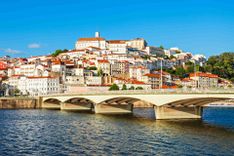


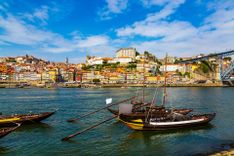










Sagres is compact but spread out enough that getting around takes a bit of planning. You can walk most places, but beaches, viewpoints, and surf spots are scattered across a wide headland. The wind is constant, and there are few shaded areas, so be prepared if you are exploring on foot. There is no local bus service within town, and taxis are limited, so having your own wheels is useful for exploring beyond the center.
If you’re wondering how many days in Sagres are enough, one full day gives you time to visit the fortress, relax on the beach, and catch the sunset at Cabo de São Vicente. But this is not a place to rush. Sagres is best when you slow down and give it space to surprise you.
If your Portugal itinerary includes time in the Algarve, plan on spending two days here. Use one to explore the town, wander the cliff paths, and watch the surfers at Tonel or Beliche. On the second day, take a drive along the coast to find quieter beaches or walk one of the coastal trails in the natural park. Staying overnight lets you enjoy the quieter side of Sagres after the day-trippers leave and gives you the chance to wake up to an ocean breeze and empty beaches.
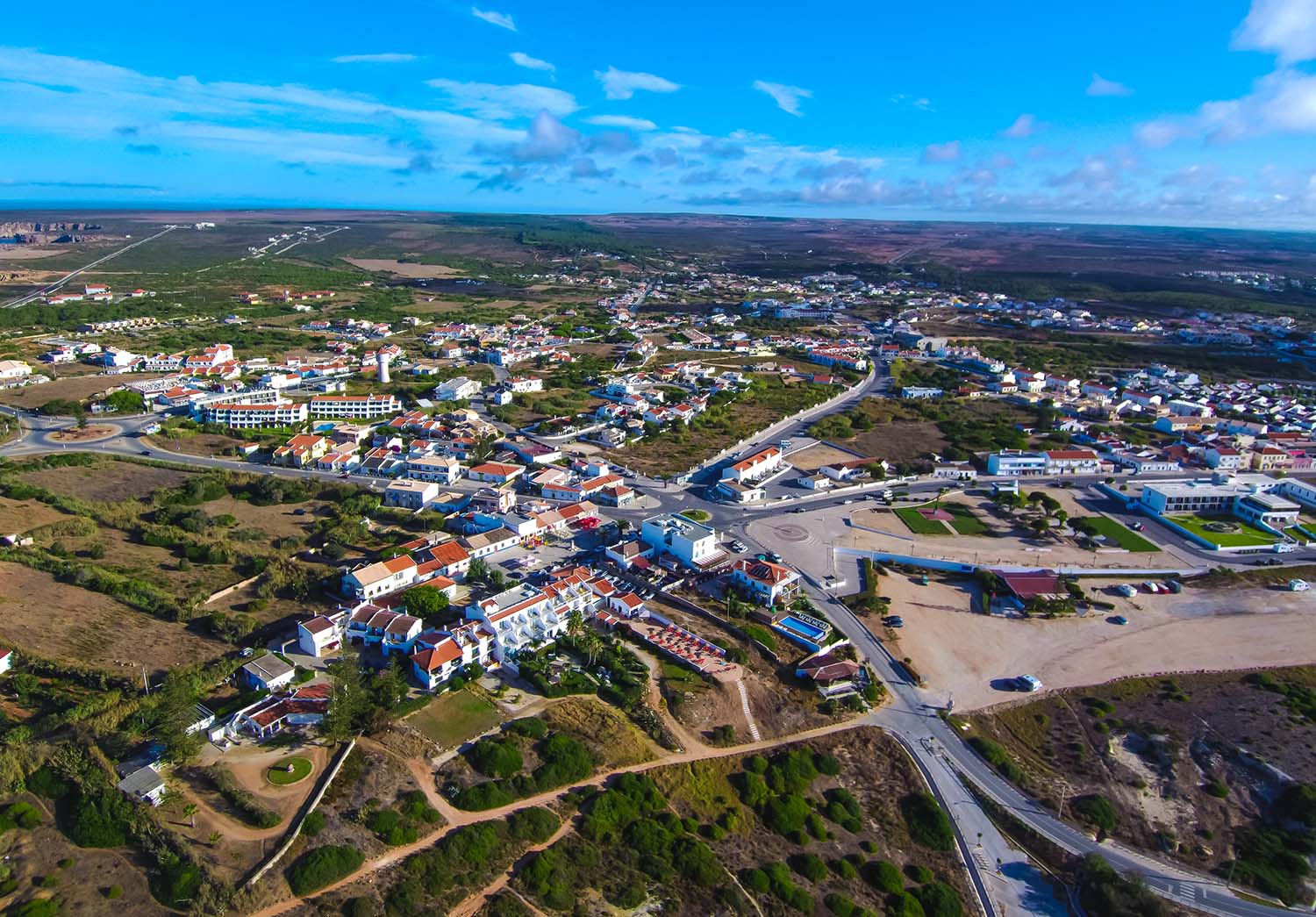
An aerial view of Sagres, Algarve, Portugal © Shutterstock
Sagres has a laid-back mix of guesthouses, surf lodges, boutique hotels, and beachside apartments. Most places are low-rise and spread out between the harbor, beaches, and town center. Where you stay depends on what kind of trip you are after.
Sagres may be small, but its wild coastal setting, deep maritime history, and surf-town energy give it a lot more punch than first impressions suggest. Here’s a breakdown of the best things to do in Sagres, no matter if you’re into wave-chasing, lighthouse views, or windswept walks along the edge of the continent.
This is where the land ends and the Atlantic begins. Cabo de São Vicente is the southwesternmost point of mainland Europe, and standing here feels like you’ve reached the planet’s last outpost. The sea stretches out endlessly, waves smash into the cliffs, and the lighthouse beams through the afternoon haze.
There is a small museum inside the lighthouse and a few snack stalls selling the famous “last bratwurst before America,” but the real draw is the atmosphere. Bring a jacket, the wind is relentless, and come late in the day for the kind of sunset that makes you stop talking mid-sentence.
Perched on a windswept headland, this 15th-century fortress was once part of Prince Henry the Navigator’s vision of turning Portugal into a maritime power. Today, it is a place to wander rather than be wowed by exhibits, but that’s part of the appeal.
Inside, you’ll find a giant stone compass carved into the ground, sea-facing battlements, and walking paths that loop around the cliffs. The views alone make it worth the visit. Early morning is best if you want the light for photos and fewer crowds.
Sagres is one of Portugal’s top surf spots, and it suits all levels. Praia do Tonel has consistent waves and a cool surf crowd, while nearby Praia do Beliche offers a more sheltered cove with powerful breaks and dramatic cliffs.
Boards and wetsuits are easy to rent in town, and lessons are available if you're starting. The water stays cool year-round, so a wetsuit is a good idea even in summer. After your session, grab a beer and watch the pros from the sand.
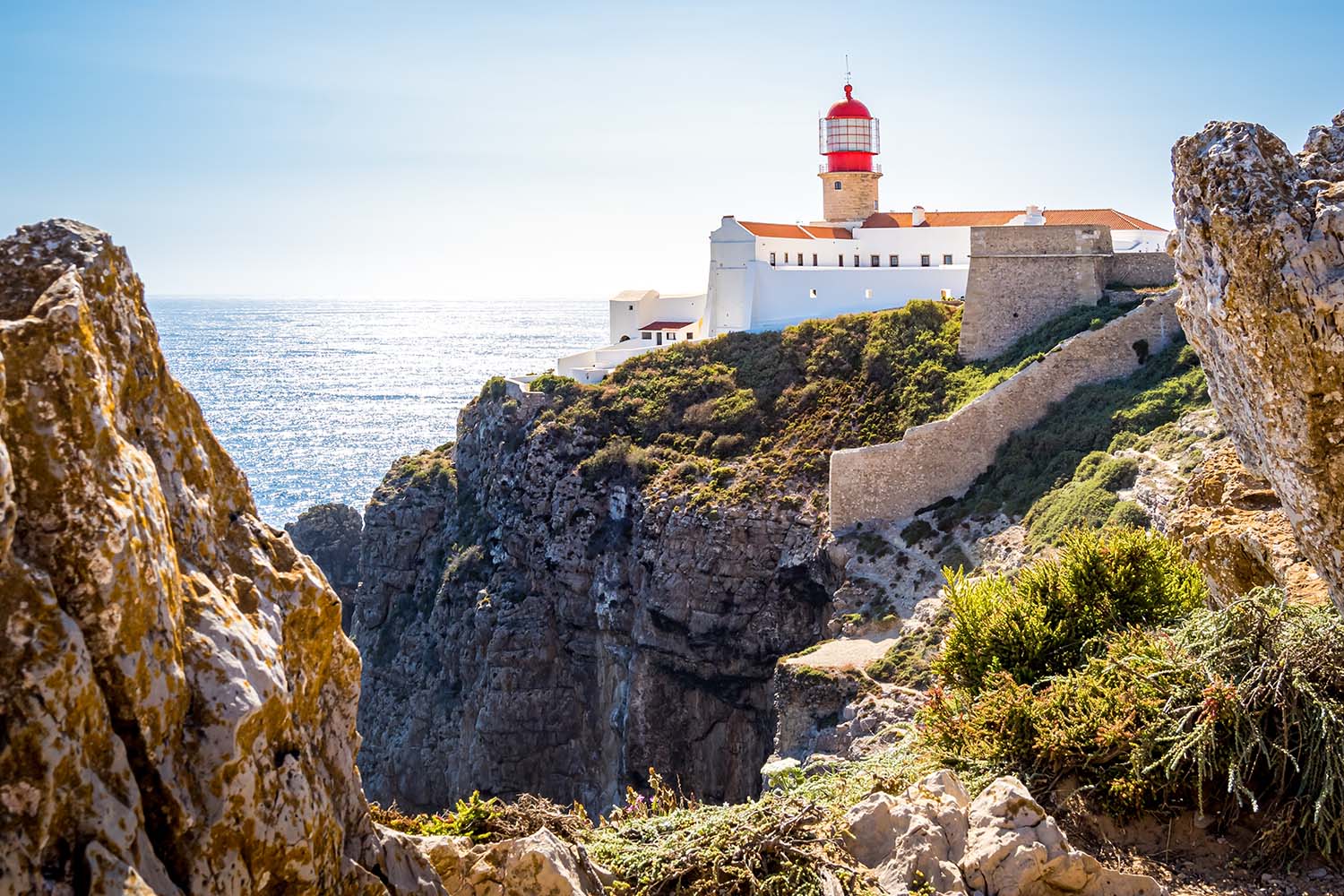
Cabo de São Vicente © Shutterstock
If surfing’s not your thing, Mareta is your beach. Tucked just below the town center, it is more sheltered than the others and has gentler waves, making it ideal for swimming. The soft sand, dramatic headlands, and walkable location have earned it a spot on more than one list of the best beaches in Portugal.
Mareta is also a solid choice for families. There are public showers, nearby cafés, and lifeguards on duty in summer. Parking is close, but limited, so arrive early if you want a spot in the shade or a quieter stretch of sand.
Sagres is surrounded by protected coastline, and the hiking here is some of the best in southern Portugal. Trails lead along dramatic cliffs, through scrubland, and down to hidden beaches. Look for wild herbs underfoot and kestrels riding the updrafts above.
One of the best short walks is from the Fortaleza to Cabo de São Vicente, following the cliffs with constant sea views. If you have more time, venture north into the Parque Natural do Sudoeste Alentejano e Costa Vicentina for longer routes with fewer people.
Sagres is still a fishing town at heart, and nowhere does that better than the harbor. Down by Praia da Baleeira, you can watch boats coming in with the daily catch, see divers unloading gear, or sit with locals at a dockside café eating grilled sardines.
It’s a good place to get a sense of everyday life in Sagres, especially in the early morning when the harbor is busiest. Some diving and boat tour companies also operate from here, offering trips to sea caves or scuba dives along the rocky coast.
Sagres keeps it simple when it comes to food, but the ingredients are fresh and full of flavor. Look for sea bass, octopus, and percebes (goose barnacles) if they are in season. Portions are generous, prices are fair, and the atmosphere is casual.
Try a tasca near the harbor for the catch of the day or a beach shack at Beliche for grilled fish with ocean views. Order house wine, soak up the sunset, and don’t be in a rush. This is a town that knows how to take its time.
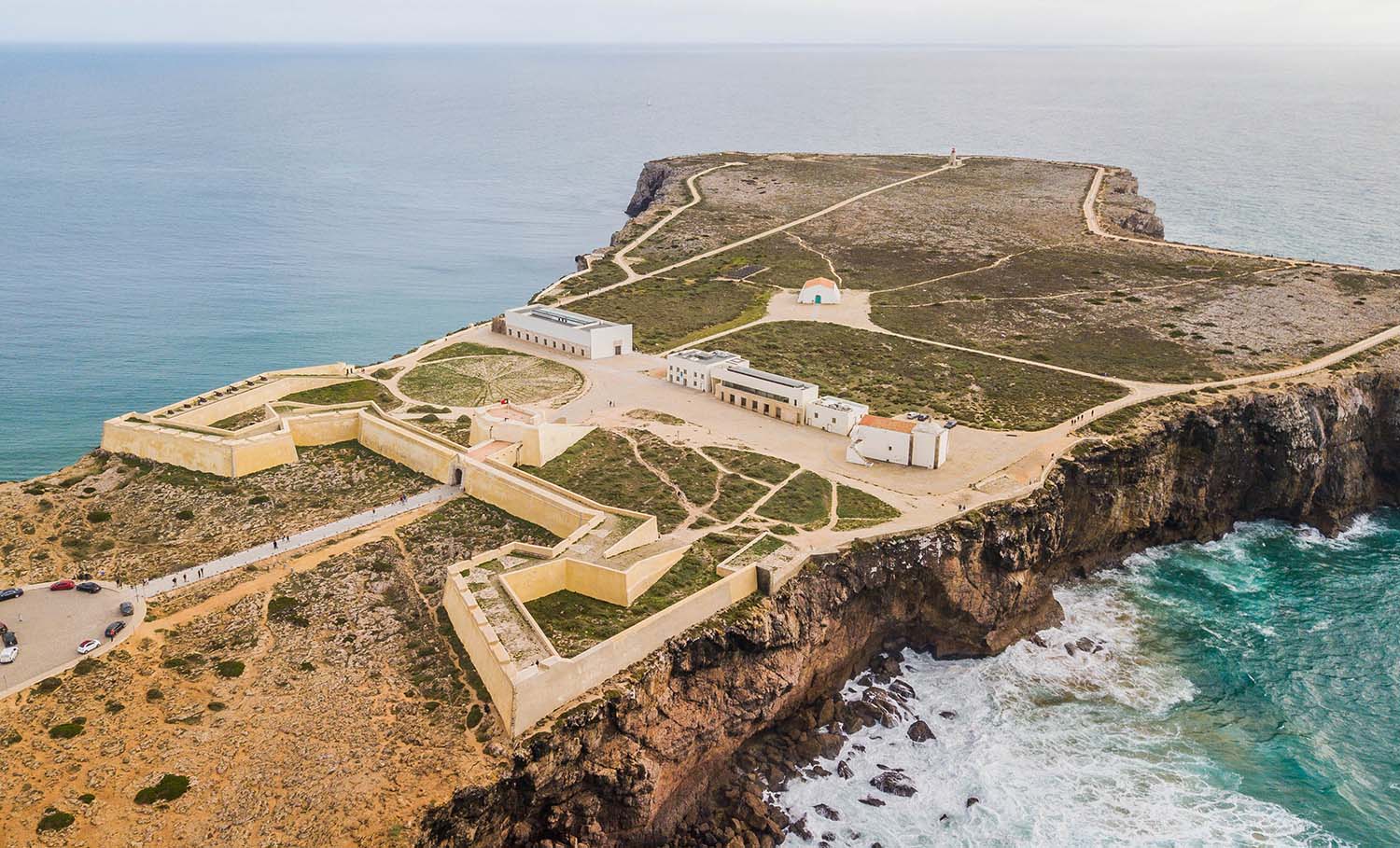
Sagres fortress, in Vila do Bispo, Portugal © Shutterstock
If you want a different perspective on the coastline, boat trips from Sagres show the cliffs from below. Small tours visit sea caves, dolphin-spotting areas, and secluded beaches that are hard to reach on foot. Some tours also include snorkeling gear or a chance to swim off the boat.
The ocean can be rough, especially in winter, so check conditions before booking. In summer, go early in the day before the afternoon wind picks up. Most boats leave from the harbor at Baleeira.
Just 10 minutes inland, Vila do Bispo is a sleepy village with a surprisingly lively farmers’ market. Held most mornings in the municipal building, it’s where locals shop for fruit, vegetables, honey, and fresh fish. There are also small cafés nearby where you can grab coffee and watch the village wake up.
It is worth a quick stop if you are self-catering or want to get a feel for life beyond the beach. Pair it with a drive to the surrounding countryside or a visit to one of the nearby surf beaches.
In Sagres, light is part of the experience. Sunsets at Cabo de São Vicente are famous, but sunrise can be just as memorable if you catch it from the cliffs near Praia do Tonel or along the path to the fortress. The sky turns pink, the sea glows silver, and the only sound is the wind and waves.
Bring a blanket, a coffee, or just your camera. It is one of the rare places where you can watch the sun rise and set over the ocean from different points on the same day.
Sagres has a classic Mediterranean climate shaped by its Atlantic exposure. That means mild winters, dry summers, and steady coastal winds that rarely let up. The wind keeps summer temperatures bearable and gives Sagres a wilder feel than more sheltered Algarve towns. Winter is cooler and quieter, with fewer tourists and moody, beautiful skies. Average temperatures range from 52°F (11°C) in January to 79°F (26°C) in August. For up-to-date conditions, check IPMA (Portuguese Institute for Sea and Atmosphere).
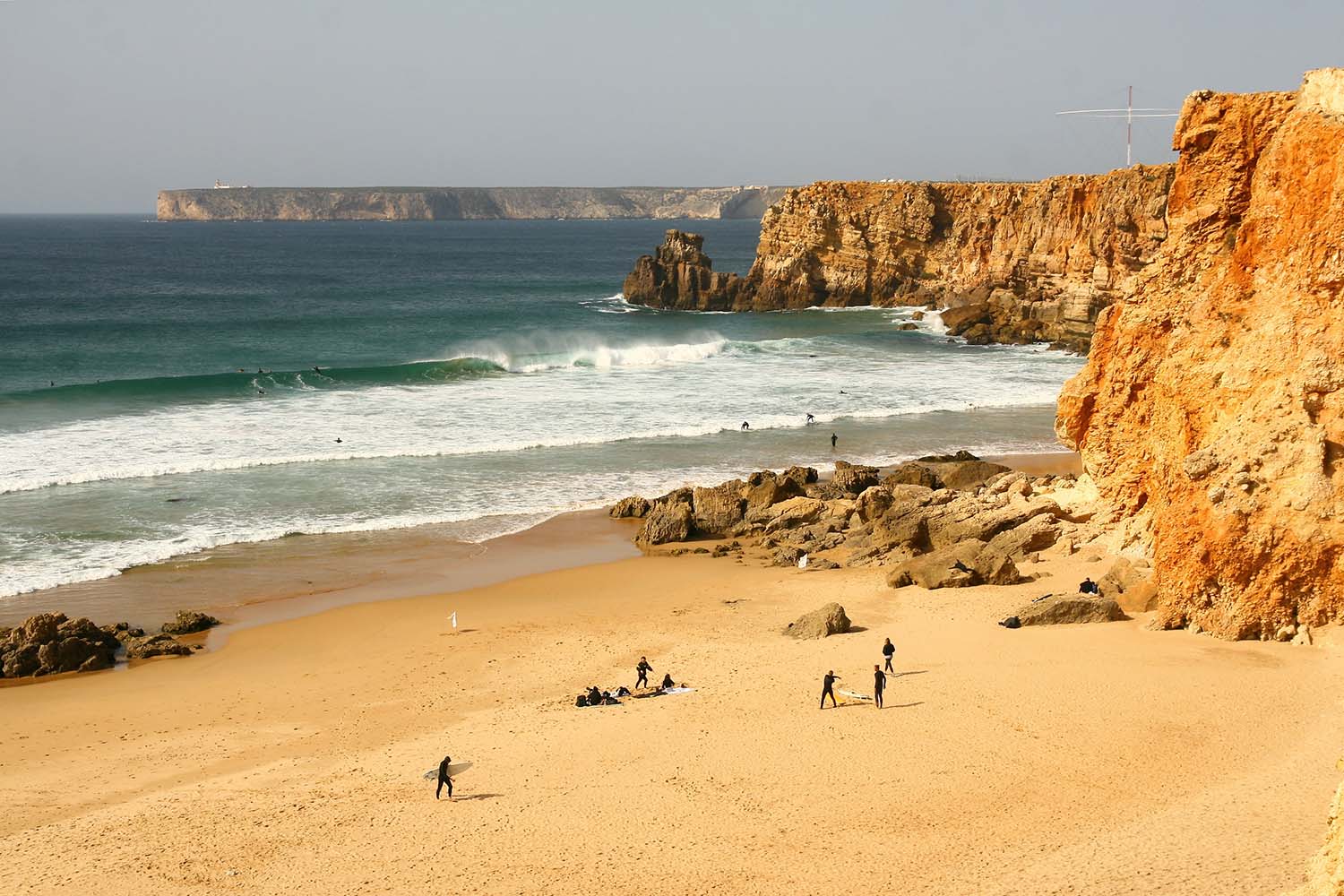
The beach of Mareta, very popular with surfers, in Sagres in the Algarve in Portugal © Shutterstock
Sagres keeps things simple when it comes to food. This is a place where the catch of the day actually means something, menus change with the tide, and grilled fish is often cooked by the person who caught it. Most places are unpretentious, with ocean views, plastic chairs, and food that speaks for itself. Expect big plates, bold flavors, and no rush to finish your meal.
Here are some unique experiences we can arrange for your tailor-made Sagres trip: all private, flexible, and designed by our local travel experts.
Discover Portugal's most captivating stories
Use Rough Guides' trusted partners for great rates
written by
Olga Sitnitsa
Online editor at Rough Guides, specialising in travel content. Passionate about creating compelling stories and inspiring others to explore the world.